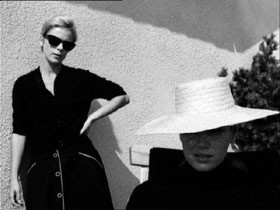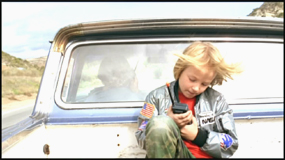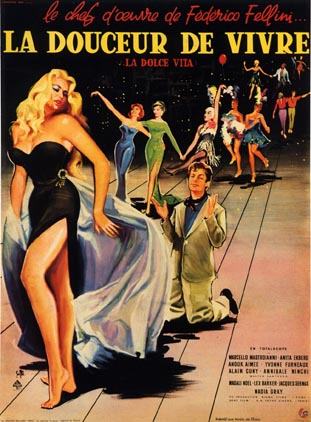 Sunset Boulevard
Sunset Boulevard (Wilder, 1950) 10/10
Before Billy Wilder’s 1950 masterpiece
Sunset Boulevard there had been very few “backstage” critiques of Hollywood and film culture. William Wellman’s 1937
A Star is Born along with Buster Keaton’s 1928 slapstick comedy
The Cameraman are some of the more acknowledged pieces prior to this period, which utilized Hollywood as its backdrop. Yet, unlike the latter two films,
Sunset Boulevard represented a more scathing and fastidious position toward Hollywood, particularly in the divide between the Old Hollywood of the silent era and the New Hollywood of the sound era. The effect of Wilder’s film was clearly evident in the immediate creation of other “Hollywood backstage” films such as :Vincente Minelli’s 1952 film
The Bad and the Beautiful; Joseph L. Mankiewicz’s 1954 film
The Barefoot Contessa; Robert Aldrich’s 1955 picture
The Big Knife; George Cukor’s 1954 remake of
A Star is Born and Stanley Donen-Gene Kelly’s 1952 musical
Singin’ in the Rain, which further ridiculed Hollywood’s silent era in a less spiteful manner.
Sunset Boulevard is the fullest and most dynamic example of Billy Wilder’s career filled acidic cruelty and satirical spite. Along with John Huston, Wilder was a director chided by influential American critic Andrew Sarris for his overarching cynicism. Yet, an examination of Sarris influential and exceptional American “auteur bible”
The American Cinema: Directors and Directions, 1929-1968. demonstrates his distaste for directors whose work holds a defeatist or pessimistic outlook. In his classification of “who is and is not an auteur”, Sarris unconsciously endorses a cinematic language that requires and hones a redeeming factor in which the central characters can be cleansed of their sins and start anew. Such characteristics are prevalent in the work of Fritz Lang, which despite his distrustful attitude toward authority, always maintains a Christian element of salvation and repentance.
[1]Sunset Boulevard however is a rare Production Code era film that has no fuzzy ending or elements of remorse amongst its principal characters. Rather it is an astringent and downbeat critique of the antithetical forces of Old and New Hollywood. In the process, no-one is spared any mercy, whether they are lowly opportunist Joe Gillis (William Holden) or eminent director Cecil B. DeMille (playing himself). In the process, Wilder creates a film that embraces a multi-genre approach: the satiric and slapstick forms of comedy; psychological and monster horror characteristics; melodramatic dramas; and the mad criminals of crime capers. Minus the western and the musical, the dominant genres of the silent period are all here, while the World War II era progeny of Film Noir is added in the utilization of its themes, concepts and lighting.
The film begins with the camera peeling back from the gutter: a helpful element of foreshadowing representative of the film’s principal characters. The first is Joe Gillis (William Holden): a B-movie screenwriter from Ohio who is being hunted by the Repo Men for back payments on his sporty convertible. The second is Norma Desmond (Gloria Swanson): a legend of the silent screen desperate to return to the spotlight and fulfill the wishes of “millions” who demand her return to the silver screen. The third is Max (Erich von Stroheim), Norma’s sad and conniving butler with a dark past. Each is at a low in their careers: stuck in a metaphorical gutter, which they hope by combining their forces with others, they can aid the resurrection of their individual careers.

After a shot reminiscent of a Warner Brothers gangster flick with an array of police cars hurdling down Sunset Blvd, we are introduced to Joe Gillis: drowned and floating in the pool of an enormous Hollywood mansion built by one of those “crazy people in the crazy twenties.”
The “crazy” individual in question is Norma Desmond, who first meets Joe in his flight from the Repo Men. A blown tire has fatefully driven him onto her estate. She thinks he is a mortician for her pet monkey; he recognizes her as a forgotten silent film star.
In their sparring chit-chat, Desmond hears that Gillis is a screenwriter and would like his assistance in assembling her lifelong work: a film about
Salome, the daughter of Herod Philip who received John the Baptist’s head on a plate. Naturally, Desmond plans to star as Salome, despite being more than thirty years too old for the part, and hopes to obtain Cecil B. DeMille as director. In his head, Gillis concocts a plan to swindle Desmond out of money in order to pay off his debts and return to Ohio.
Yet, unbeknownst to Gillis, he is the one who is being used. As Max will reveal later in the film, Norma Desmond uses men for her own sexual gratification. Her materialism and vanity is apparent in the grandiose opulence of her home and her line of Norma Desmond photographs. Significantly, the only films shown at her home are Norma Desmond silent pictures. She is a figure distinctly from the silent era. Her actions and movements are wildly over-the-top in stark contrast to Joe Gillis’ New Hollywood subtleness. With its wheezing organ and cavernous walls the home is reminiscent of a Universal Horror film: a fact made even more prescient in Norma Desmond’s claw-like fingers and expressive make-up. Her home has become her own world: a representation of herself, which has become a safe-zone from a period that has abandoned her. Here, Chaplin is replicated, Valentino is reminisced and “The Waxworks” featuring silent stars such as Buster Keaton and Hal Warner play cards: it has become a shrine to the silent era and an abode for the dead and the forgotten.
When Gillis steps into this world, he turns it upside down. His virility and youthful energy are increasingly utilized less for screenwriting and more as a plaything for Norma. The effect is typified in a New Years celebration in which despite a sophisticated dinner and expensive orchestra, the only guests are Gillis and Norma Desmond. Yet, Wilder’s cruelty is often in the latter half of the film replaced by sympathy. Despite her narcissistic demeanour, Norma can be at times warm and appealing toward Joe Gillis. She buys him gifts, pays his bills and cultures him. Materially she offers Joe anything he wants, yet she cannot offer him the type of relationship he desires. The source of Norma’s fan letters is revealed in Max’s intricate plot to continue her stardom and prevent her from further suicidal “bouts of melancholy”: a blow made even more crushing when Norma is invited back to Paramount Studios not to make
Salome with DeMille as she believes, but rather to borrow her antique car for an upcoming period piece. Even DeMille is not spared in this heart-breaking scene in which for fifteen minutes Norma regains her stardom, as he equally appears foolish and out of touch with the modern era.

Wilder does provide Gillis with an outlet to break free from Norma in the form of a script writing job with Betty Schaefer (Nancy Olson). Yet, Gillis’ adulterous adventure with Betty turns out to be ruinous. It is also significantly one of the rare moments when the characters do exert moments of guilt and regret; yet it is only as a minute response to their own selfish greed. Ideas of fate and chance are abound in
Sunset Boulevard. And its fate that Holden’s character reluctantly accepts not as a Hollywood scriptwriter, but as Norma Desmond’s solitary member of what “On Sunset Boulevard” author Ed Sikov refers to on the Paramount DVD commentary as ‘a male harem: a bordello of one.’
Sex was a taboo subject in 1950, yet
Sunset Boulevard is dripping with ideas of sex throughout its 110 minute running time. The theme of power is a crucial element to
Sunset Boulevard. Here power is manifested into the ability to control one’s sexuality. In the case of Joe Gillis he is unable to do so and thus is as much an emasculated servant as Max, without the uniform. Norma’s forceful clout as a star and material power allow her to obtain anything she wants, including Joe Gillis. After abandoning Norma’s genuine romantic advances at the New Years Party, he clearly ends his chances at having a relationship built on love and cooperation. His return after Norma’s suicide demonstrates his own capitulation. Although guilt holds some sway in his decision, Gillis’ lust for money draws him back to Norma Desmond, which results in Gillis prostituting himself even further.
Wilder gives the film an additional element of spite in his utilization of realistic locations such as Paramount Studios, figures and semi-autobiographical elements, most notably in the tense relationship between von Stroheim and Swanson, which was a touchy subject in itself considering their failed project
Queen Kelly (the silent film shown in the picture at the suggestion of von Stroheim) effectively ended von Stroheim's career behind the camera.

Another director may have not tried to push his actors to the edge in a story with such personal undertones, yet Wilder’s ability to do so results in a subservient tension between the pair throughout the film. Yet, this tension not only represents the conflict between von Stroheim and Swanson, but also the conflict between the characters of the decayed and exaggerated mannerisms of Old Hollywood and the ungrateful, yet realistic tones of New Hollywood. The end-product is some of the most dynamic performances and cinema ever put to celluloid.
[1] See Fury or Metropolis for such examples
*
Sunset Boulevard is available through Paramount Home Video
Copyright 2006 8 ½ Cinematheque.
Labels: Holden, Noir, Paramount, von Stroheim, Wilder


 Peckinpah's lyrical gunplay and editing come to the forefront in the 2005 "Special Edition Cut" made by Peckinpah scholars based upon Peckinpah's writings and the supposed aesthetical intentions of the late director. Certainly, while this isn't a director's cut it does add something new to the process and provides something less extensive than the '88 Preview Version, which may be more in line with Peckinpah's vision. Ultimately, this is a splendidly bleak and grimy Western that tramples on the last remnants of the Western mythology with cold calculated precision and flair. It is at least a minor classic of American cinema and Westerns in general, rather than a fully fledged flawless work.
Peckinpah's lyrical gunplay and editing come to the forefront in the 2005 "Special Edition Cut" made by Peckinpah scholars based upon Peckinpah's writings and the supposed aesthetical intentions of the late director. Certainly, while this isn't a director's cut it does add something new to the process and provides something less extensive than the '88 Preview Version, which may be more in line with Peckinpah's vision. Ultimately, this is a splendidly bleak and grimy Western that tramples on the last remnants of the Western mythology with cold calculated precision and flair. It is at least a minor classic of American cinema and Westerns in general, rather than a fully fledged flawless work.













 Upon arriving in Texas, Walt is appalled to find that his brother has snuck away from the physician’s office in order to continue his eternal search in the desert. When Walt catches up with Travis, he is given a cold response. Despite Walt’s efforts to re-immerse him into the fold, Travis eventually steals away again in his vain quest to return to the wilderness. Yet, once more Walt corrals his estranged brother and demands an answer to Travis’ behaviour. However like the static and muted television in their motel room, Walt receives nothing but silence and disorientation.
Upon arriving in Texas, Walt is appalled to find that his brother has snuck away from the physician’s office in order to continue his eternal search in the desert. When Walt catches up with Travis, he is given a cold response. Despite Walt’s efforts to re-immerse him into the fold, Travis eventually steals away again in his vain quest to return to the wilderness. Yet, once more Walt corrals his estranged brother and demands an answer to Travis’ behaviour. However like the static and muted television in their motel room, Walt receives nothing but silence and disorientation.
 When Travis’ is finally reunited with Jane his response is frigid and aggressive. He detests what she has become, but more so he detests what he has forced her to become due to his past actions. Wender’s lush long takes and the performances by Stanton and Kinski during these scenes are beautiful, yet difficult. Like Bergman’s Scenes From a Marriage, Wenders traps his audience by exercising the scenes between the estranged couple in gorgeous extended takes that demonstrate the multiple sides to the couple. Upon their first meeting Travis listens while Jane talks in a meaningless, watery tone. Yet, the tables are later turned with Jane tearfully listening, while Travis concocts a painful allegory in a striking contrast to Jane’s destitute speech. It is here that we see Travis realize the folly of his four years of pain and strife.
When Travis’ is finally reunited with Jane his response is frigid and aggressive. He detests what she has become, but more so he detests what he has forced her to become due to his past actions. Wender’s lush long takes and the performances by Stanton and Kinski during these scenes are beautiful, yet difficult. Like Bergman’s Scenes From a Marriage, Wenders traps his audience by exercising the scenes between the estranged couple in gorgeous extended takes that demonstrate the multiple sides to the couple. Upon their first meeting Travis listens while Jane talks in a meaningless, watery tone. Yet, the tables are later turned with Jane tearfully listening, while Travis concocts a painful allegory in a striking contrast to Jane’s destitute speech. It is here that we see Travis realize the folly of his four years of pain and strife.



